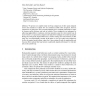Free Online Productivity Tools
i2Speak
i2Symbol
i2OCR
iTex2Img
iWeb2Print
iWeb2Shot
i2Type
iPdf2Split
iPdf2Merge
i2Bopomofo
i2Arabic
i2Style
i2Image
i2PDF
iLatex2Rtf
Sci2ools
ISER
2004
Springer
2004
Springer
Comparison of Temporal Filters for Optical Flow Estimation in Continuous Mobile Robot Navigation
We present our complete study involving comparisons of three spatio-temporal used in the estimation of optical flow for continuous mobile robot navigation. Previous comparisons of optical flow and associated techniques have compared performance in terms of accuracy and/or efficiency, and only in isolation. These comparisons are inadequate for addressing applicability to continuous, real-time operation as part of a robot control loop. In recent work [11], we presented a comparison of optical flow techniques for corridor navigation through two biologically inspired behaviours: corridor centring and visual odometry. In that study, flow was predominantly constant. In this paper we give new results from comparisons for flow-divergence based docking, where flow is non-constant. Results for traditionally used Gaussian filters indicate that long latencies significantly impede performance for real-time tasks in the control loop.
| Added | 02 Jul 2010 |
| Updated | 02 Jul 2010 |
| Type | Conference |
| Year | 2004 |
| Where | ISER |
| Authors | Chris McCarthy, Nick Barnes |
Comments (0)

